Modeling Wicking Fabric Inhibition Effect on Frost Heave
Abstract
:Featured Application
Abstract
1. Introduction
2. Coupled THM Modeling
2.1. Governing Equations
2.2. Coupled Parameters
2.2.1. Thermal Properties
2.2.2. Hydraulic Properties
2.2.3. SWCC and SFCC
2.3. Actual Evaporation of WF
3. Frost Heave Test of the Soil Column
3.1. Material Properties and Parameters
3.2. Experimental Setup
3.3. Testing Method
3.3.1. Soil Column Preparation
3.3.2. Test Procedures
4. Numerical Simulations with Coupled THM Analysis
5. Results and Discussions
5.1. Reliability of the Proposed Model
5.2. Parametric Analysis
5.2.1. Effect of Soil Types
5.2.2. Effect of Groundwater Level
5.2.3. Effect of Cooling Rate
6. Conclusions
- (1)
- A THM coupled FE model, which can simulate the freezing process of unsaturated soil, was combined with an evaporation model to evaluate the WF inhibition effect of frost heave under different situations. The proposed model can describe the influence of the surrounding environment, such as the saturation and temperature of the soil, on WF.
- (2)
- To examine the validity of the proposed model, the simulation results were compared to the experimental results. As a result, it was verified that the proposed model could sufficiently predict the temperature, moisture, and frost heave of the soil column in the frost heave test, and that the proposed model could simulate the suppression effect of WF on frost heave under different conditions.
- (3)
- The results from both the experimental and numerical simulations demonstrate that WF can effectively inhibit the occurrence of frost heave. This indicates that the proposed model is able to reproduce the transient evaporation process of WF during freezing, whose rate changes in accordance with the soil saturation and temperature, and that it can simulate the inhibition effect of WF on frost heave under different conditions.
- (4)
- The soil type, GWL, and cooling rate affect the inhibition effect of WF on frost heave strain in frost-susceptible soils. The WF was more effective in reducing frost heave on sandy soils than on clay soils. For the same freezing time, a higher freezing rate tends to cause less frost heave, and the inhibition effect of WF on frost heave is correspondingly weakened. On the other hand, when the GWL is increased, it also reduces the effectiveness of WF in preventing frost heave.
Author Contributions
Funding
Institutional Review Board Statement
Informed Consent Statement
Data Availability Statement
Acknowledgments
Conflicts of Interest
References
- Peppin, S.S.L.; Style, R.W. The physics of frost heave and ice-lens growth. Vadose Zone J. 2013, 12, vzj2012.0049. [Google Scholar] [CrossRef] [Green Version]
- Berg, R.L.; Guymon, G.L.; Johnson, T.C. Mathematical Model to Correlate Frost Heave of Pavements with Laboratory Predictions; Cold Regions Research and Engineering Laboratory: Hanover, NH, USA, 1980. [Google Scholar]
- Holtz, R.D.; Kovacs, W.D.; Sheahan, T.C. An Introduction to Geotechnical Engineering; Prentice-Hall: Hoboken, NJ, USA, 1981; pp. 259–267. [Google Scholar]
- Kinosita, S. Preventing measures against frost action in soils. In Proceedings of the International Symposium on Frost in Geotechnical Engineering, Saariselka, Finland, 13–15 March 1989. [Google Scholar]
- Ye, Y.S.; Wang, Z.J.; Cheng, A.J.; Luo, M.Y. Frost heave classification of railway subgrade filling material and the design of anti-freezing layer. China Railw. Sci. 2007, 28, 1–7. [Google Scholar]
- Sheng, D. Thermodynamics of Freezing Soils: Theory and Application. Ph.D. Thesis, Luleå Tekniska Universitet, Luleå, Sweden, 1994. [Google Scholar]
- Lin, C.; Presler, W.; Zhang, X.; Jones, D.; Odgers, B. Long-term performance of wicking fabric in Alaskan pavements. J. Perform. Constr. Facil. 2017, 31, D4016005. [Google Scholar] [CrossRef]
- Zhang, X.; Presler, W. Use of H2Ri Wicking Fabric to Prevent Frost Boils in the Dalton Highway Beaver Slide Area, Alaska; No. INE/AUTC 12.23; Alaska University Transportation Center: Fairbanks, AK, USA, 2012. [Google Scholar]
- Zornberg, J.G.; Azevedo, M.; Sikkema, M.; Odgers, B. Geosynthetics with enhanced lateral drainage capabilities in roadway systems. Transp. Geotech. 2017, 12, 85–100. [Google Scholar] [CrossRef]
- Zhang, X.; Presler, W.; Li, L.; Jones, D.; Odgers, B. Use of wicking fabric to help prevent frost boils in Alaskan pavements. J. Mater. Civ. Eng. 2014, 26, 728–740. [Google Scholar] [CrossRef]
- Currey, J. H2Ri Wicking Fabric Experimental Feature Final Report Dalton Highway MP 197–209 Rehabilitation; Final Project Report; Alaska Department of Transportation and Public Facilities: Fairbanks, AK, USA, 2016. [Google Scholar]
- Garcia Delgado, I.E. Use of Geotextiles with Enhanced Lateral Drainage in Roads over Expansive Clays. Ph.D. Thesis, The University of Texas at Austin, Austin, TX, USA, 2015. [Google Scholar]
- Han, J.; Zhang, X. Recent advances in the use of geosynthetics to enhance sustainability of roadways. In Proceedings of the International Conference on Advances in Civil Engineering for Sustainable Development, Nakhon Ratchasima, Thailand, 27–29 August 2014. [Google Scholar]
- Guo, J.; Han, J.; Zhang, X.; Li, Z. Evaluation of moisture reduction in aggregate base by wicking geotextile using soil column tests. Geotext. Geomembr. 2019, 47, 306–314. [Google Scholar] [CrossRef]
- Lin, C.; Zhang, X.; Han, J. Comprehensive material characterizations of pavement structure installed with wicking fabrics. J. Mater. Civ. Eng. 2019, 31, 04018372. [Google Scholar] [CrossRef]
- Yasuoka, T.; Ishikawa, T.; Luo, B.; Wu, Y.; Maruyama, K.; Ueno, C. Coupled Analysis on Frost-Heaving Depression Effect of Geosynthetics Drainage Material for Road Pavement. In Proceedings of the 4th International Conference on Transportation Geotechnics, Chicago, IL, USA, 24–27 May 2022. [Google Scholar]
- De Vries, D.A. Simultaneous transfer of heat and moisture in porous media. Trans. Am. Geophys. Union 1958, 39, 909–916. [Google Scholar] [CrossRef]
- Nassar, I.N.; Horton, R. Water transport in unsaturated nonisothermal salty soil: II. Theoretical development. Soil Sci. Soc. Am. J. 1989, 53, 1330–1337. [Google Scholar] [CrossRef]
- Nassar, I.N.; Horton, R. Simultaneous transfer of heat, water, and solute in porous media: I. Theoretical development. Soil Sci. Soc. Am. J. 1992, 56, 1350–1356. [Google Scholar] [CrossRef]
- Celia, M.A.; Binning, P. A mass conservative numerical solution for two-phase flow in porous media with application to unsaturated flow. Water Resour. Res. 1992, 28, 2819–2828. [Google Scholar] [CrossRef]
- Fayer, M.J. UNSAT-H version 3.0: Unsaturated Soil Water and Heat Flow Model Theory, User Manual, and Examples; No. 820201000; Pacific Northwest National Laboratory: Richland, WA, USA, 2000. [Google Scholar]
- Noborio, K.; McInnes, K.J.; Heilman, J.L. Two-dimensional model for water, heat, and solute transport in furrow irrigated soil: II. Field evaluation. Soil Sci. Soc. 1996, 60, 1010–1021. [Google Scholar] [CrossRef]
- Konrad, J.M. Estimation of the segregation potential of fine-grained soils using the frost heave response of two reference soils. Can. Geotech. J. 2005, 42, 38–50. [Google Scholar] [CrossRef]
- Zhao, Y.; Nishimura, T.; Hill, R.; Miyazaki, T. Determining hydraulic conductivity for air-filled porosity in an unsaturated frozen soil by the multistep outflow method. Vadose Zone J. 2013, 12, vzj2012.0061. [Google Scholar] [CrossRef]
- Liu, Q.; Wang, Z.; Li, Z.; Wang, Y. Transversely isotropic frost heave modeling with heat–moisture–deformation coupling. Acta Geotech. 2020, 15, 1273–1287. [Google Scholar] [CrossRef] [Green Version]
- Côté, J.; Konrad, J.M. A generalized thermal conductivity model for soils and construction materials. Can. Geotech. J. 2005, 42, 443–458. [Google Scholar] [CrossRef]
- Anderson, D.M.; Tice, A.R.; McKim, H.L. The unfrozen water and the apparent specific heat capacity of frozen soils. In Proceedings of the Second International Conference on Permafrost, Yakutsk, Russia, 13–28 July 1973. [Google Scholar]
- Harlan, R.L. Analysis of coupled heat-fluid transport in partially frozen soil. Water Resour. Res. 1973, 9, 1314–1323. [Google Scholar] [CrossRef] [Green Version]
- Hansson, K.; Šimunek, J.; Mizoguchi, M.; Lundin, L.C.; Van Genuchten, M.T. Water flow and heat transport in frozen soil: Numerical solution and freeze–thaw applications. Vadose Zone J. 2004, 3, 693–704. [Google Scholar]
- Flerchinger, G.N.; Saxton, K.E. Simultaneous heat and water model of a freezing snow-residue-soil system I. Theory and development. Trans. ASAE 1989, 32, 565–571. [Google Scholar] [CrossRef]
- Dall’Amico, M.; Endrizzi, S.; Gruber, S.; Rigon, R.J.T.C. A robust and energy-conserving model of freezing variably-saturated soil. Cryosphere 2011, 5, 469–484. [Google Scholar] [CrossRef] [Green Version]
- Mualem, Y. A new model for predicting the hydraulic conductivity of unsaturated porous media. Water Resour. Res. 1976, 12, 513–522. [Google Scholar] [CrossRef] [Green Version]
- Jame, Y.W.; Norum, D.I. Phase Composition of a Partially Frozen Soil; Agricultural Engineering Department, University of Saskatchewan: Saskatoon, SK, Canada, 1973. [Google Scholar]
- Taylor, G.S.; Luthin, J.N. A model for coupled heat and moisture transfer during soil freezing. Can. Geotech. J. 1978, 15, 548–555. [Google Scholar] [CrossRef]
- Jame, Y.M. Heat and mass transfer in freezing unsaturated soil in a closed system. In Proceedings of the 2nd Conference on Soil Water Problems in Cold Regions, Edmonton, AB, Canada, 1–2 September 1976. [Google Scholar]
- Shoop, S.A.; Bigl, S.R. Moisture migration during freeze and thaw of unsaturated soils: Modeling and large scale experiments. Cold Reg. Sci. Technol. 1997, 25, 33–45. [Google Scholar] [CrossRef]
- Guo, J.; Wang, F.; Zhang, X.; Han, J. Quantifying water removal rate of a wicking geotextile under controlled temperature and relative humidity. J. Mater. Civ. Eng. 2017, 29, 04016181. [Google Scholar] [CrossRef]
- Fredlund, M.D.; Tran, D.; Fredlund, D.G. Methodologies for the calculation of actual evaporation in geotechnical engineering. Int. J. Geomech. 2016, 16, D4016014. [Google Scholar] [CrossRef]
- Penman, H.L. Natural evaporation from open water, bare soil, and grass. Proc. R. Soc. Lond. A Math. Phys. Sci. 1948, 193, 120–145. [Google Scholar]
- Tetens, O. Uber einige meteorologische Begriffe. Z. Geophys. 1930, 6, 297–309. [Google Scholar]
- Guymon, G.L.; Berg, R.L.; Hromadka, T.V. Mathematical Model of Frost Heave and Thaw Settlement in Pavements; Cold Regions Research and Engineering Laboratory: Hanover, NH, USA, 1993. [Google Scholar]
- Ishikawa, T.; Tokoro, T.; Akagawa, S. Frost Heave Behavior of Unsaturated Soils Under Low Overburden Pressure and Its Estimation. In Proceedings of the 68th Canadian Geotechnical Conference and the 7th Canadian Permafrost Conference, Québec, QC, Canada, 20–23 September 2015. [Google Scholar]
- Nakamura, D.; Suzuki, T.; Goto, T.; Kim, H.; Ito, Y.; Yamashita, S. Changes in the permeability coefficient and the void ratio of compacted soil by the effect of freeze-thaw cycles. J. Jpn. Soc. Civ. Eng. Ser. C 2011, 67, 264–275. [Google Scholar] [CrossRef]
- Ueda, Y.; Orai, T.; Tamura, T. Study on the Frost Heave Ratios in Triaxial Directions of Soil Based on Effective Stresses Consideration. J. JSCE 2005, 806, 67–78. [Google Scholar] [CrossRef]
- Stuurop, J.C.; van der Zee, S.E.M.; Voss, C.I.; French, H.K. Simulating water and heat transport with freezing and cryosuction in unsaturated soil: Comparing an empirical, semi-empirical and physically-based approach. Adv. Water Resour. 2021, 149, 103846. [Google Scholar] [CrossRef]
- Luo, B.; Ishikawa, T.; Tokoro, T.; Lai, H. Coupled Thermo-Hydro-Mechanical Analysis of Freeze–Thaw Behavior of Pavement Structure over a Box Culvert. Transp. Res. Rec. 2017, 2656, 12–22. [Google Scholar] [CrossRef]
- Tokoro, T.; Ishikawa, T.; Akagawa, S. Temperature dependency of permeability coefficient of frozen soil. In Proceedings of the 69th Annual Canadian Geotechnical Conference, Vancouver, BC, Canada, 2–5 October 2016. [Google Scholar]
- Liu, Z.; Yu, X. Coupled thermo-hydro-mechanical model for porous materials under frost action: Theory and implementation. Acta Geotech. 2011, 6, 51–65. [Google Scholar] [CrossRef]
- Japanese Industrial Standards Committee. Test Method for Density of Soil Particles JIS A 1202; Japanese Standards Association: Tokyo, Japan, 2009. (In Japanese) [Google Scholar]
- Japanese Industrial Standards Committee. Test Method for Density of Soil Particles JIS A 1204; Japanese Standards Association: Tokyo, Japan, 2009. (In Japanese) [Google Scholar]
- Japanese Industrial Standards Committee. Test Method for Density of Soil Particles JIS A 1210; Japanese Standards Association: Tokyo, Japan, 2009. (In Japanese) [Google Scholar]
- Japanese Geotechnical Society. Japanese Geotechnical Society Standards—Laboratory Testing Standards of Geomaterials; Maruzen Publishing Co., Ltd.: Tokyo, Japan, 2015. [Google Scholar]
- Japanese Geotechnical Society. JGS 0171-2009 Test Method for Frost Heave Prediction of Soils; Japanese Geotechnical Society: Tokyo, Japan, 2009. [Google Scholar]
- Japanese Geotechnical Society. JGS 0172-2009 Test Method for Frost Susceptibility of Soils; Japanese Geotechnical Society: Tokyo, Japan, 2009. [Google Scholar]
- Beskow, G. Soil freezing and frost heaving with special application to roadsand railroads. Swed. Geol. Surv. Yearb. 1935, 26, 375. (In Swedish) [Google Scholar]
- Sheng, D.; Zhang, S.; Yu, Z.; Zhang, J. Assessing frost susceptibility of soils using PCHeave. Cold Reg. Sci. Technol. 2013, 95, 27–38. [Google Scholar] [CrossRef] [Green Version]



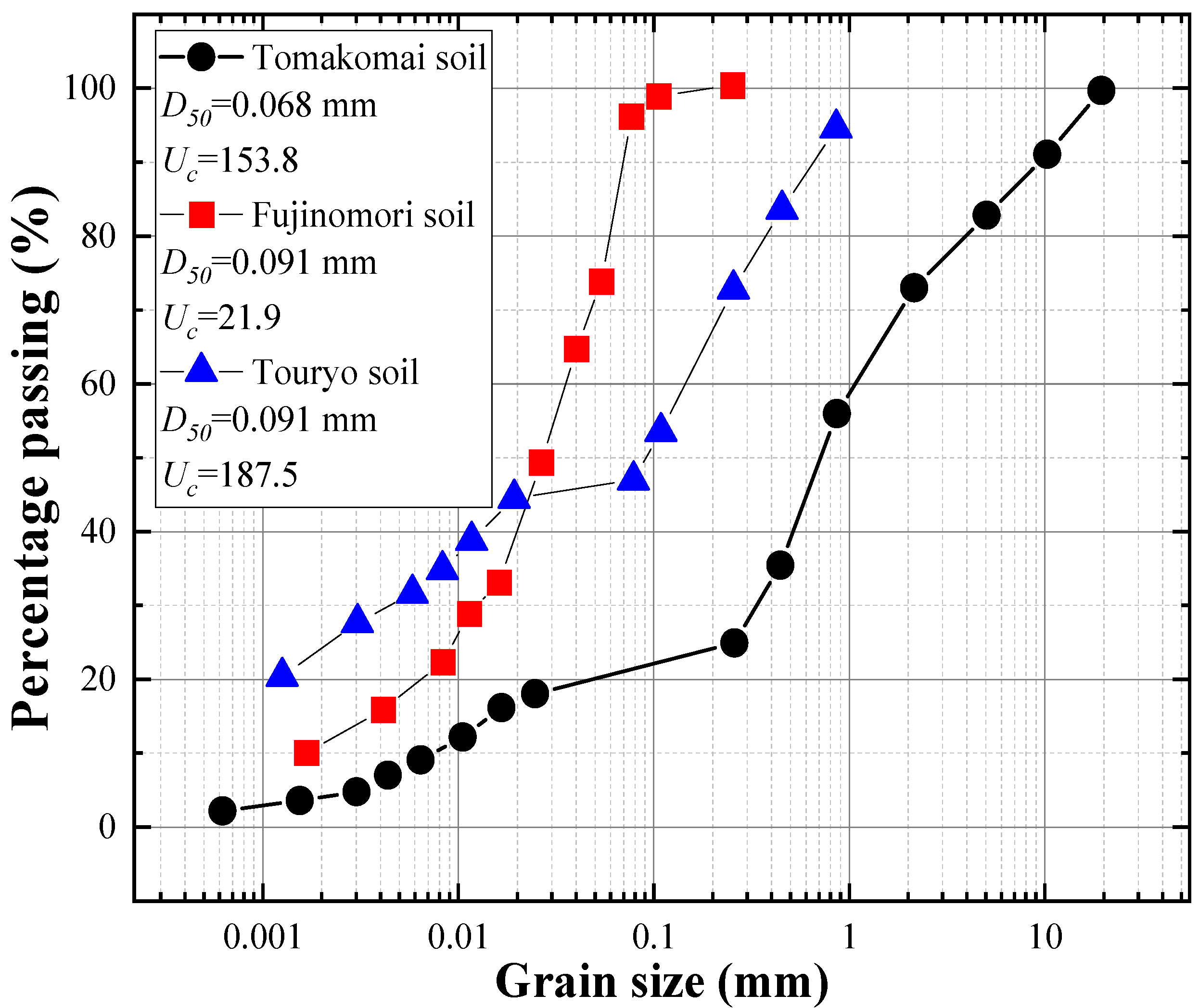
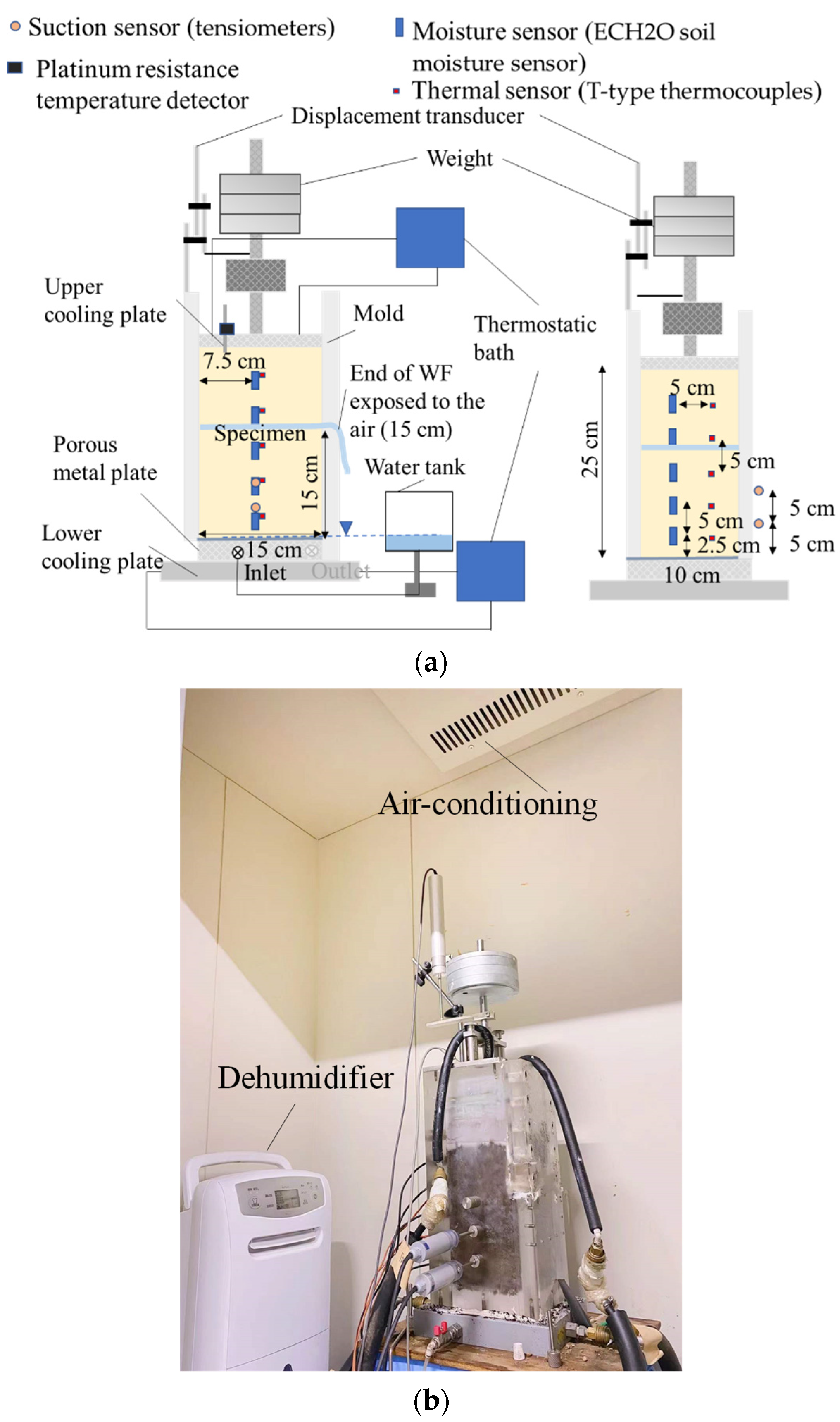
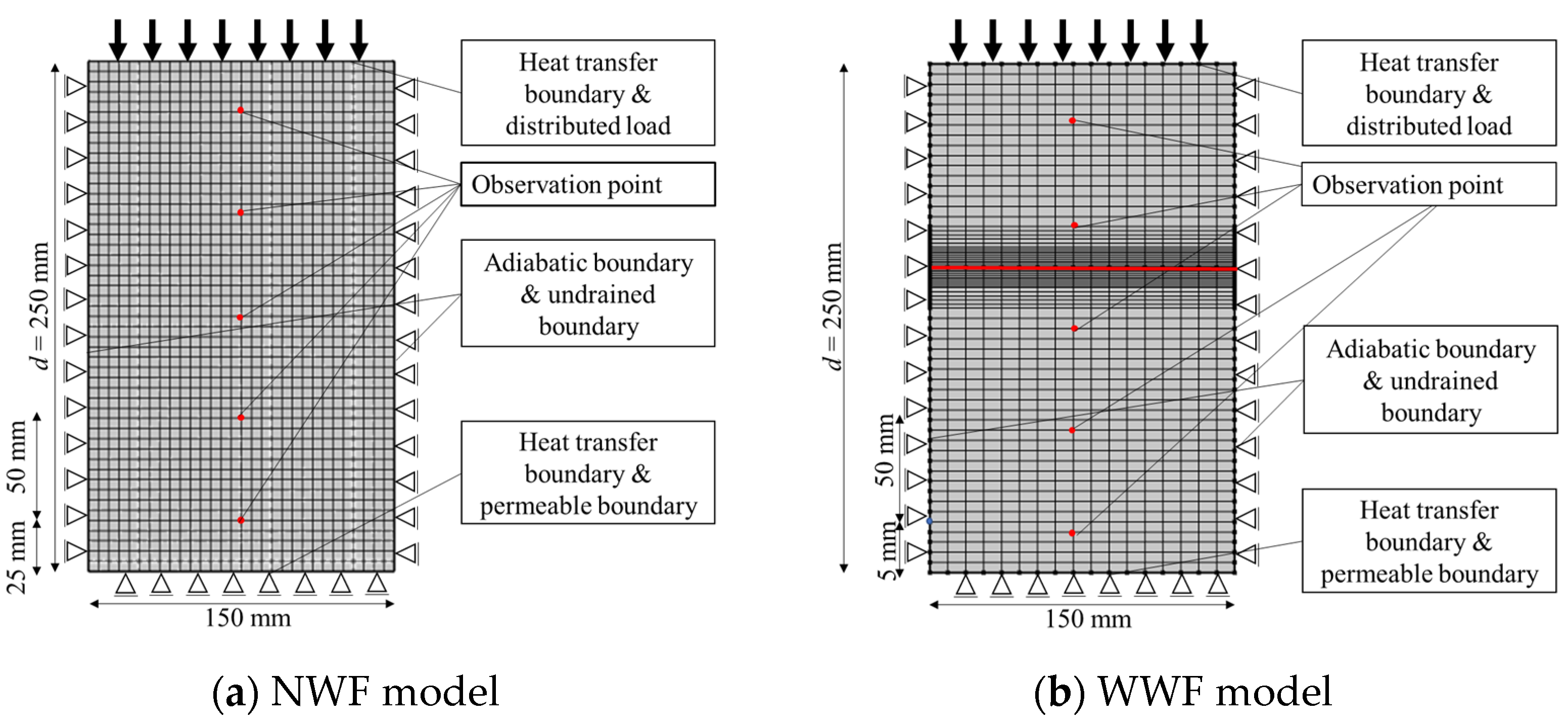
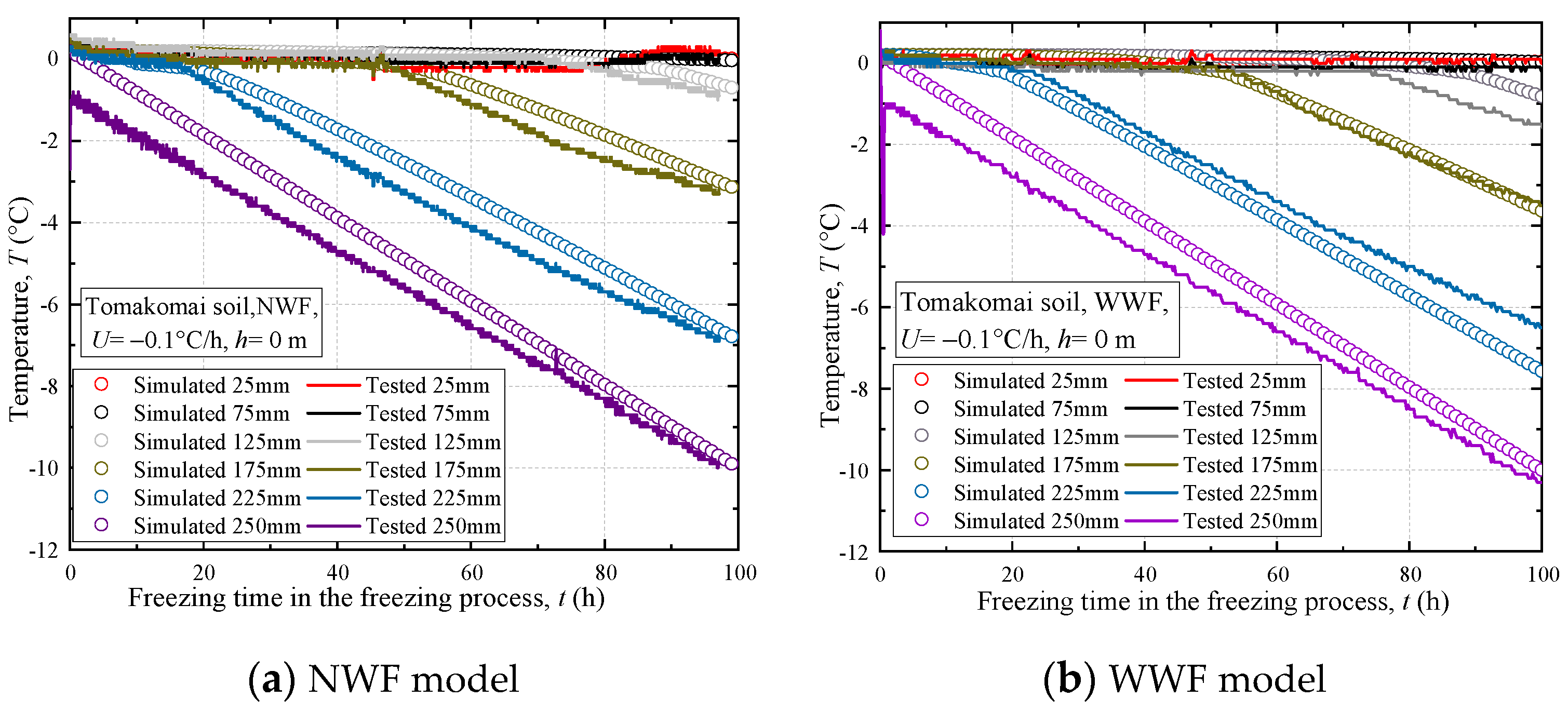
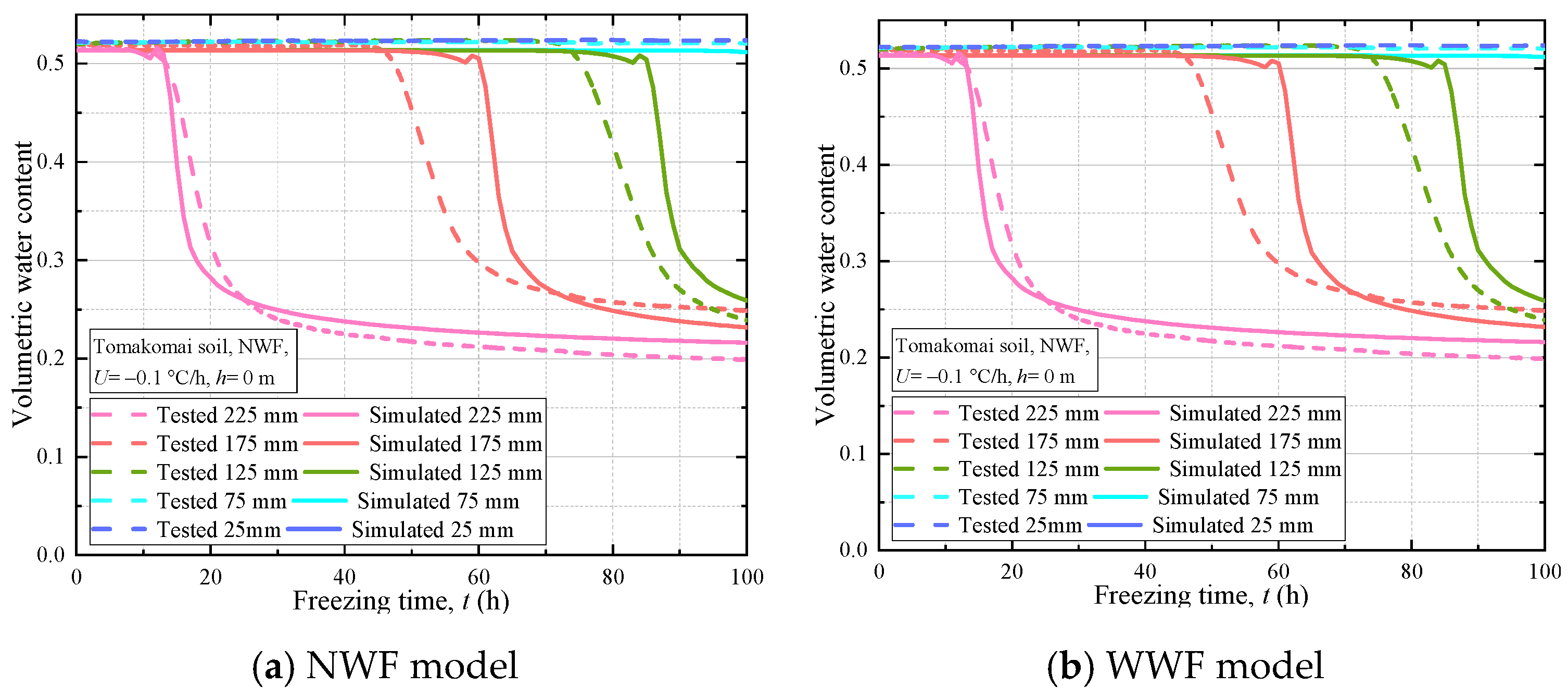
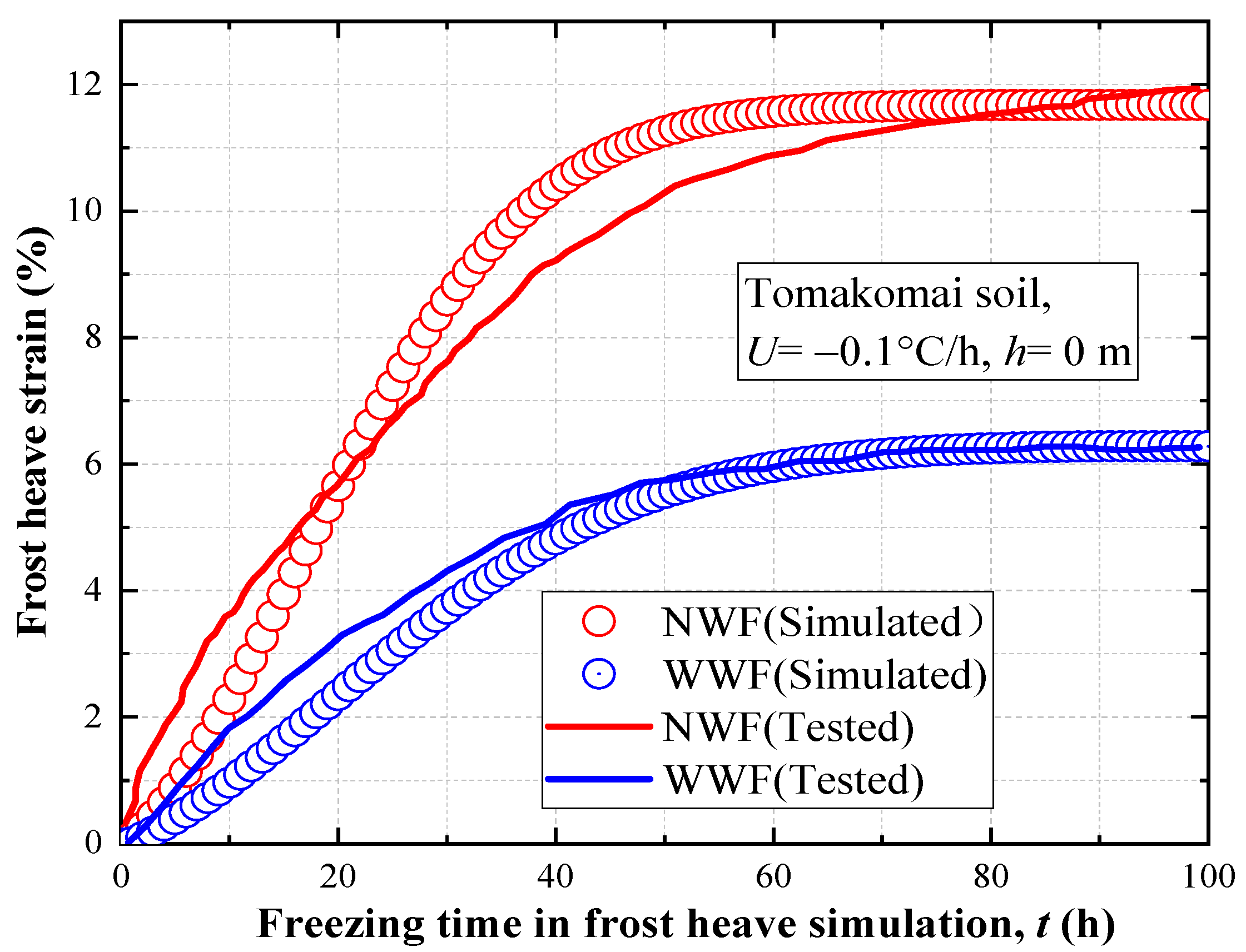
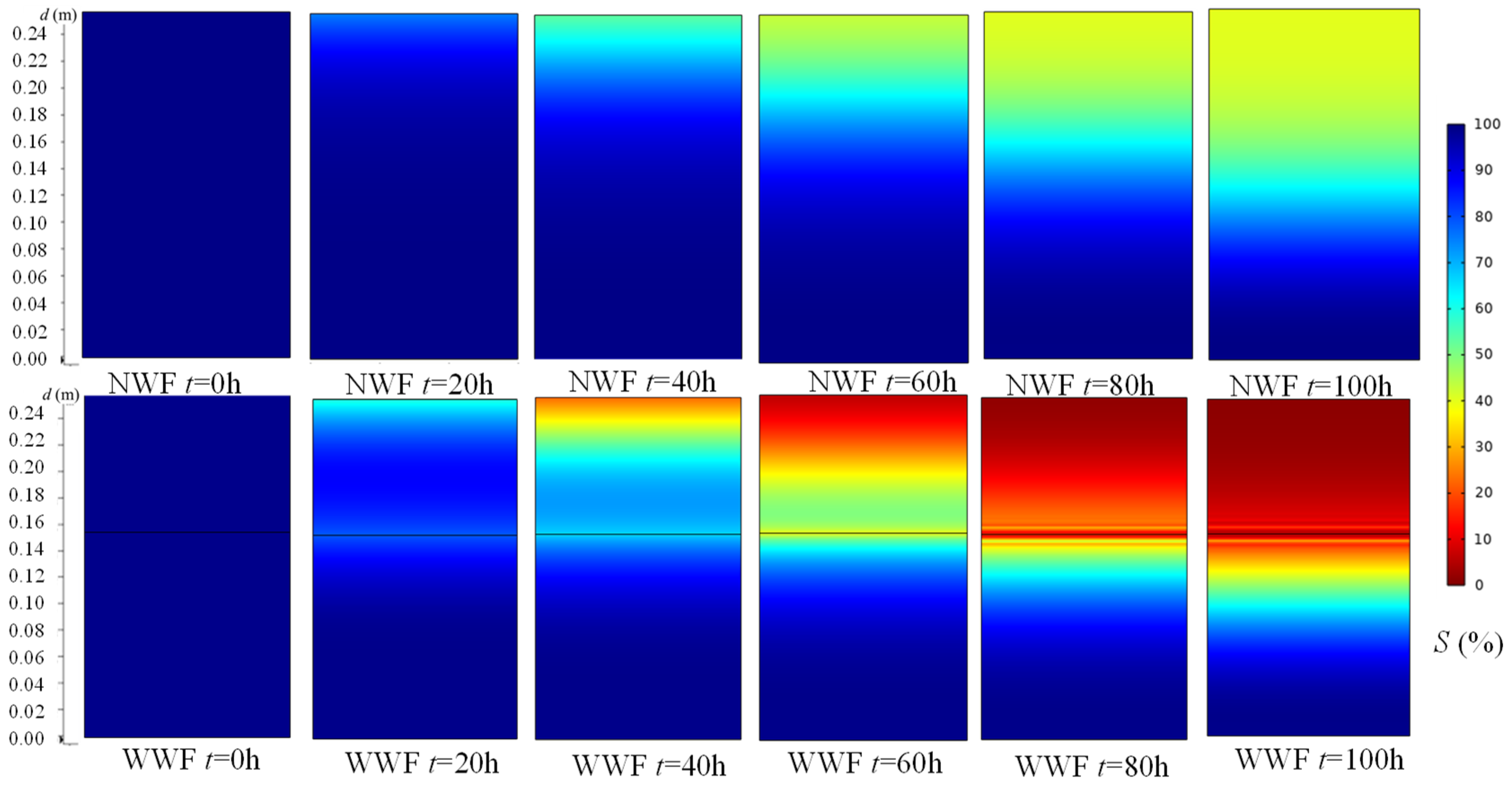
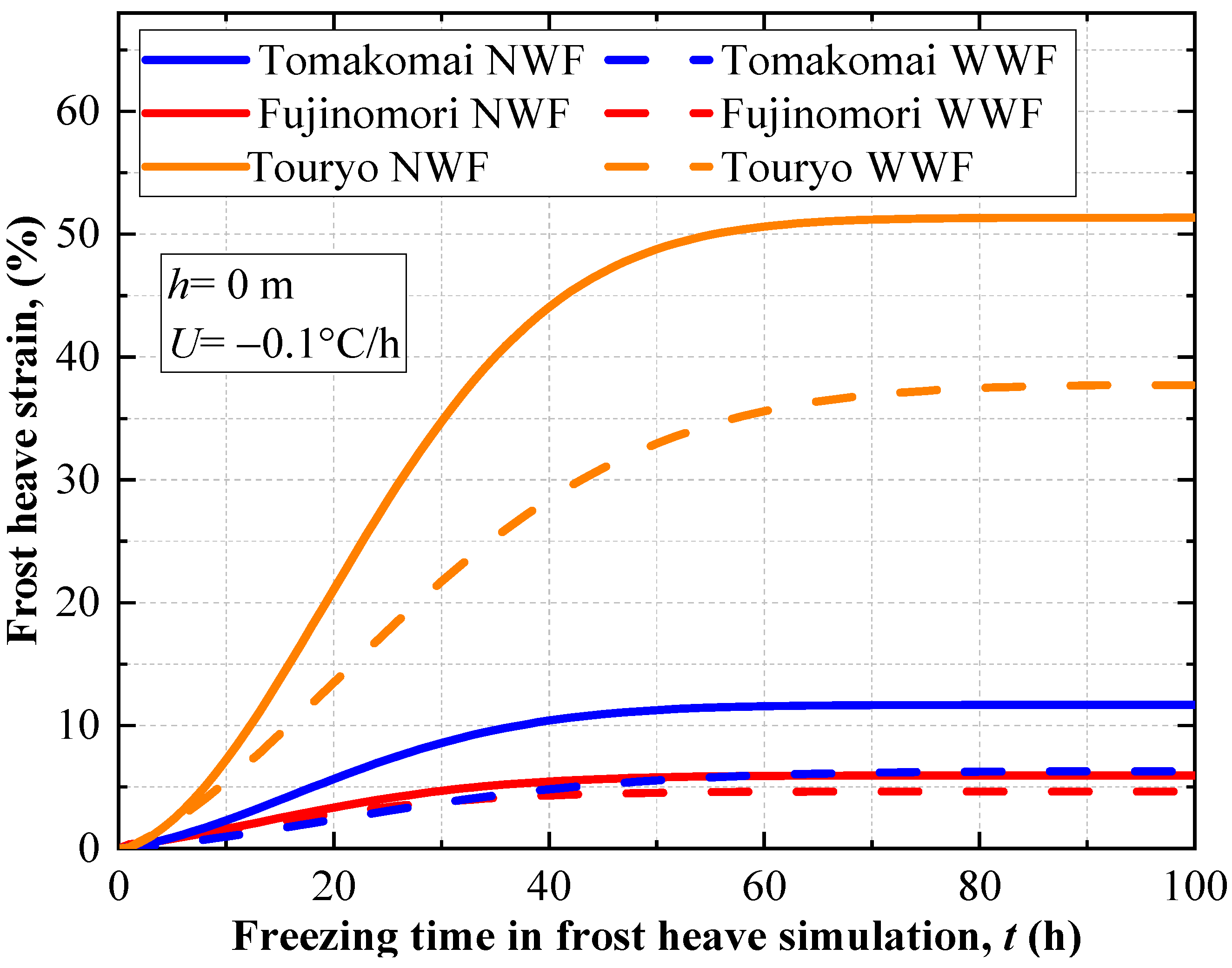
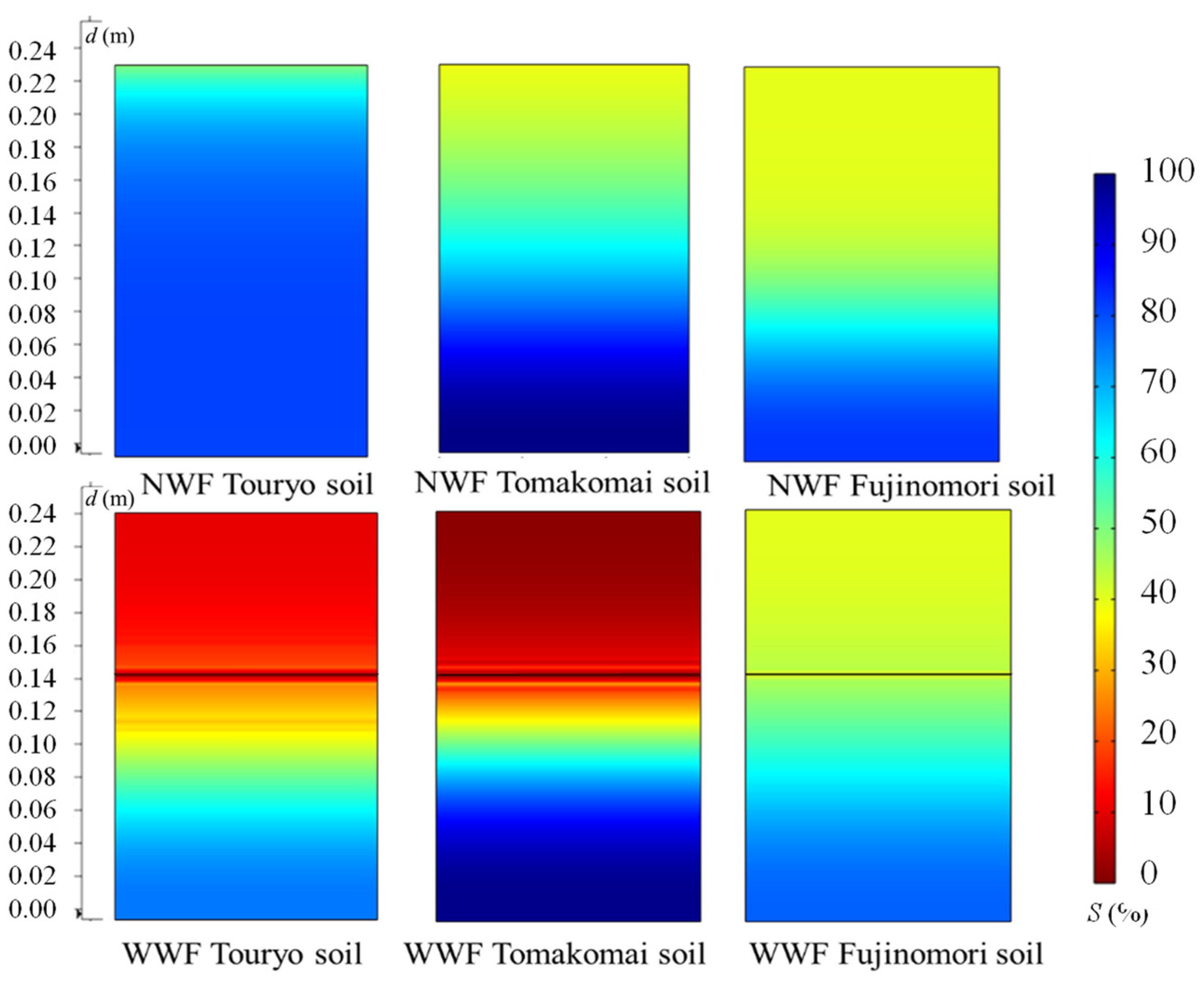
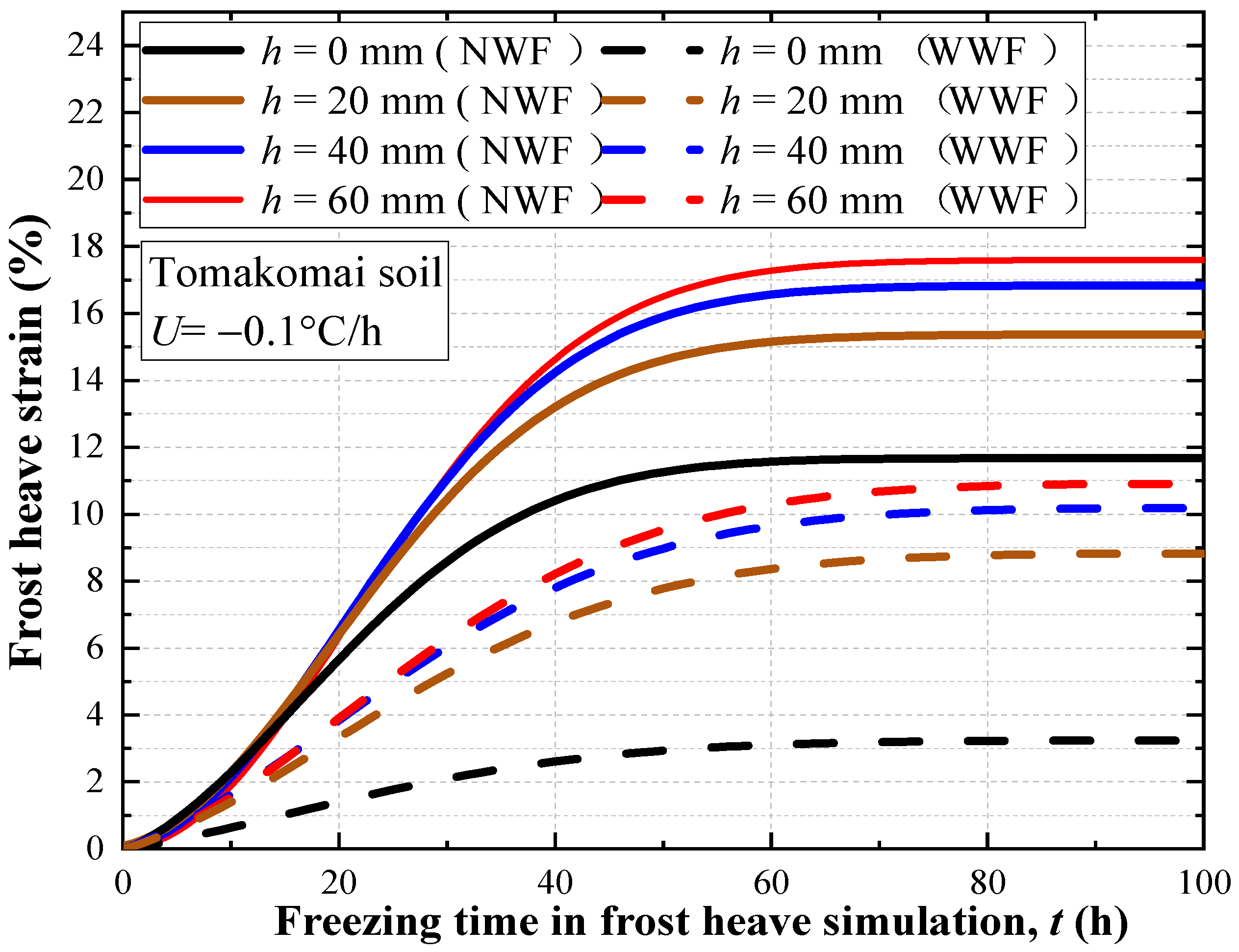
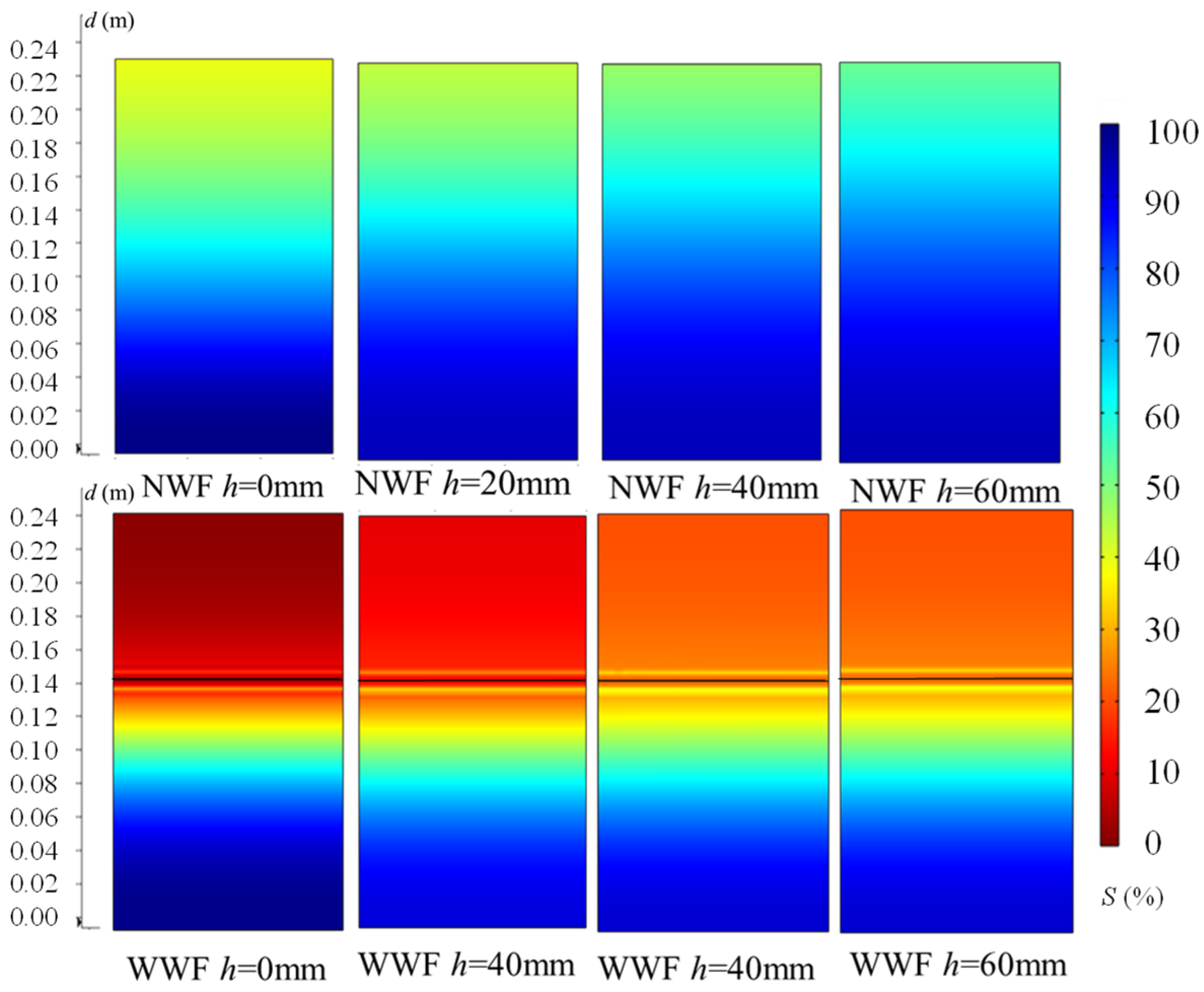
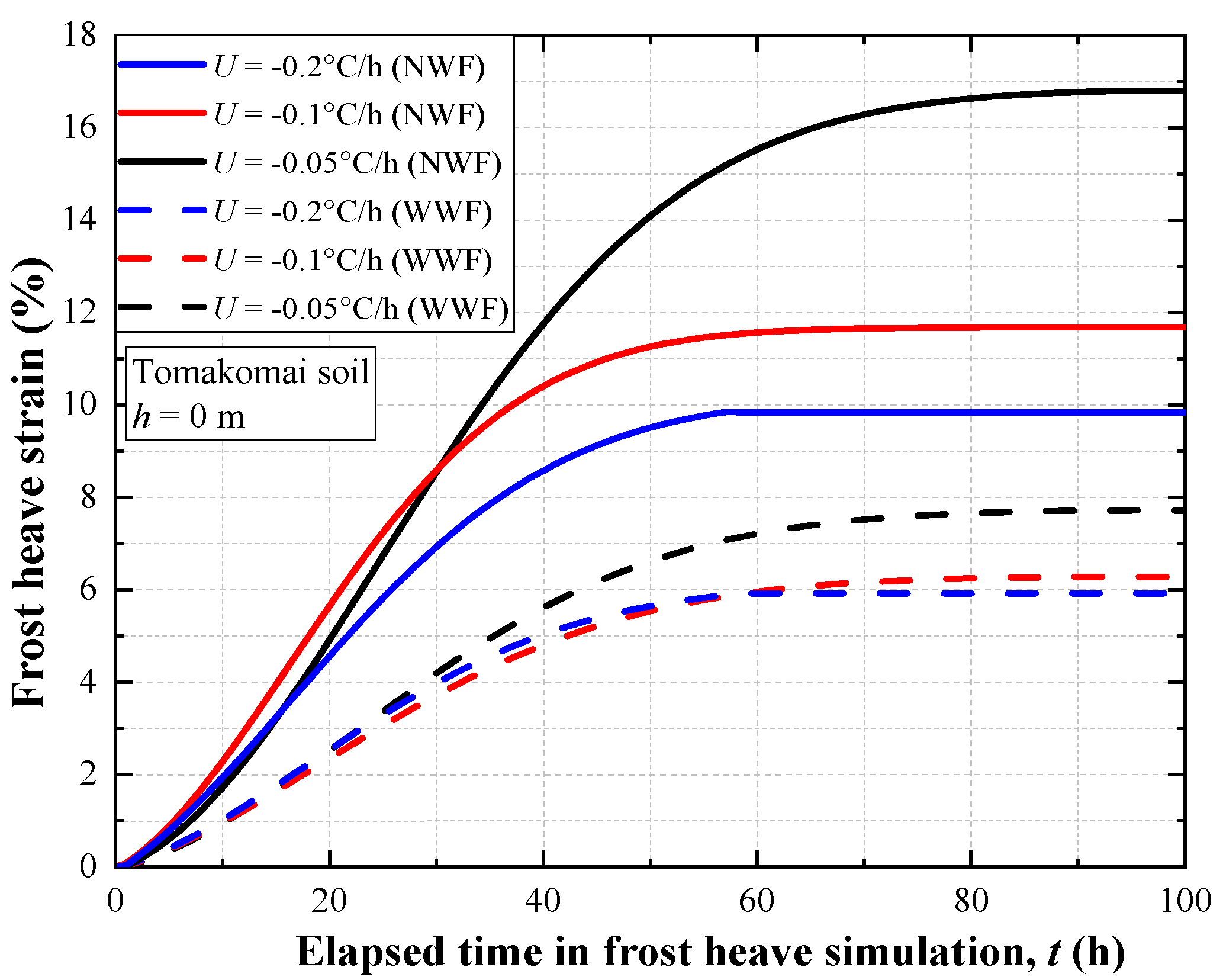
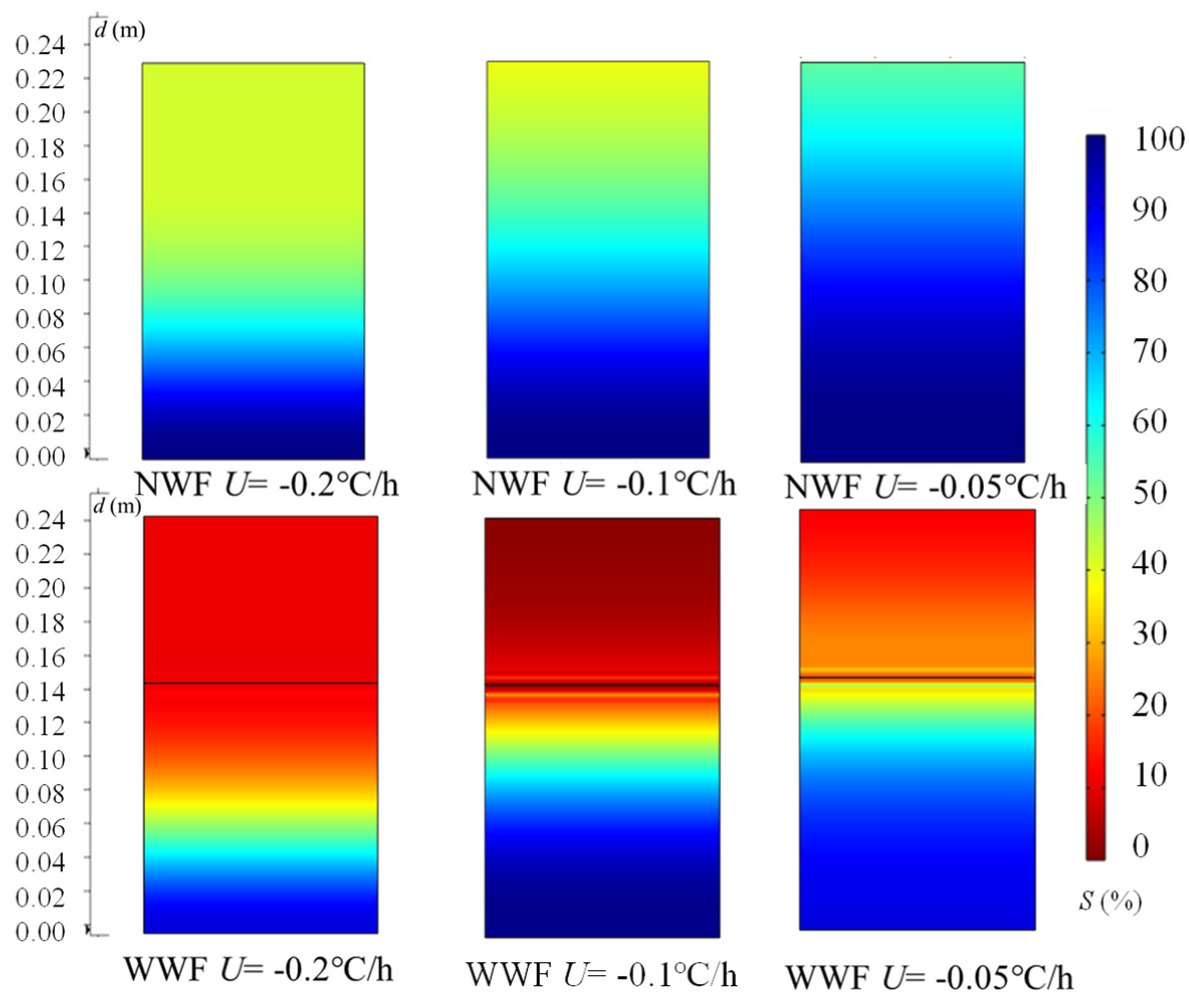
| Abbreviation/Symbol | Parameter/Variable | Units |
|---|---|---|
| volumetric heat capacity of the soil mixture | ||
| heat capacity of the soil particles | ||
| heat capacity of the | ||
| heat capacity of the | ||
| apparent volumetric heat capacity | ||
| hydraulic capacity | ||
| thermal conductivity of saturated soil | ||
| thermal conductivity of dry soil | ||
| thermal conductivity of the soil | ||
| normalized thermal conductivity | ||
| thermal conductivity of ice | ||
| thermal conductivity of unfrozen water | ||
| thermal conductivity of the soil mixture | ||
| porosity of the soil | 1 | |
| freezing temperature of the soil | ||
| material parameters accounting for the particle shape effect | 1 | |
| material parameters accounting for the particle shape effect | 1 | |
| an empirical parameter used to account for the different soil types in the unfrozen and frozen states | 1 | |
| temperature in the soil mixture | ||
| volumetric unfrozen water content | 1 | |
| volumetric ice content | 1 | |
| degree of saturation | 1 | |
| effective saturation | 1 | |
| saturated water hydraulic conductivity | ||
| saturated matric potential | ||
| hydraulic conductivity of the soil | ||
| total hydraulic head | m | |
| unit vector along the direction of gravity | 1 | |
| fourth-order tensor of material stiffness | 1 | |
| displacement vector | 1 | |
| body force vector | 1 | |
| matric suction | ||
| relative humidity of the overlaying air | 1 | |
| AE | actual evaporation | |
| PE | potential evaporation | |
| the slope of the saturation vapor pressure versus the temperature curve at the mean temperature of the air | 1 | |
| heat budget | 1 | |
| aerodynamic evaporative term | 1 | |
| saturation vapor pressure of the mean air temperature | ||
| actual vapor pressure of the air | ||
| wind speed | ||
| maximum temperature of the air | ||
| minimum temperature of the air | ||
| maximum relative humidity of the air | 1 | |
| minimum relative humidity of the air | 1 |
| Parameter | Value | Units | |
|---|---|---|---|
| latent heat of fusion | 334,000 | ||
| density of ice | 916 | ||
| density of water | 1000 | ||
| dimensional empirical parameter | 0.7 | 1 | |
| gravity acceleration | 9.8 | m/s2 | |
| molecular mass of water | 0.018 | kg/mol | |
| unit mass of water | 9807 | kN/m3 | |
| universal gas constant | 8314 | ) | |
| psychrometric constant | 66.8 | Pa/°C |
| Abbreviation/ Symbol | Parameter | Value | Unit | ||
|---|---|---|---|---|---|
| Touryo Soil | Fujinomori Soil | Tomakomai Soil | |||
| Volumetric heat capacity of the soil particles | 1.8 × 106 | 1.3 × 106 | 8.59 × 105 | ||
| Thermal conductivity of the soil mixture | 1.61 | 0.83 | 1.61 | ||
| Material parameters accounting for the particle shape effect | 0.75 | 0.75 | 0.75 | ||
| Material parameters accounting for the particle shape effect | 1.2 | 1.2 | 1.2 | 1 | |
| Dry density of soil particles | 1400 | 1460 | 1200 | ||
| Porosity | 0.45 | 0.455 | 0.55 | 1 | |
| Final freezing temperature at atmospheric pressure | 272.95 | 272.90 | 273.05 | ||
| Van Genuchten–Mualem fitting parameter | 93.2 | 1.904 | 25.02 | ||
| Van Genuchten–Muale fitting parameter | 1.596 | 1.865 | 1.54 | 1 | |
| Saturated degree of saturation | 96.7 | 100 | 95.1 | % | |
| Residual degree of saturation | 37.8 | 18.5 | 33.5 | % | |
| Saturated water hydraulic conductivity | 1 × 10−8 | 5 × 10−10 | 9.16 × 10−9 | ||
| Thermal expansion coefficient | 1.2 × 10−5 | 1.2 × 10−5 | 1.2 × 10−6 | ||
| Young’s modulus of soil | 40 | 12.5 | 8.5 | ||
| Modulus related to matric potential | 7653 | 7653 | 7653 | ||
| Poisson’s ratio | 0.4 | 0.33 | 0.4 | 1 | |
| WWF | NWF | |||
|---|---|---|---|---|
| Simulated | Tested | Simulated | Tested | |
| U0 (mm/h) | 1.724 | 1.882 | 1.587 | 1.562 |
| Uh (mm/h) | 0.157 | 0.156 | 0.276 | 0.295 |
| l0 (mm) | 172.4 | 188.2 | 158.7 | 156.2 |
| (%) | 6.28 | 6.26 | 11.04 | 11.79 |
| Number | Soil Type | GWL l (m) | U (°C/h) | WF Installation |
|---|---|---|---|---|
| 1 | Touryo soil | 0 | −0.1 | WWF |
| 2 | Fujinomori soil | 0 | −0.1 | WWF |
| 3 | Tomakomai soil | 0 | −0.1 | WWF |
| 4 | Touryo soil | 0 | −0.1 | NWF |
| 5 | Fujinomori soil | 0 | −0.1 | NWF |
| 6 | Tomakomai soil | 0 | −0.1 | NWF |
| 7 | Tomakomai soil | 0.02 | −0.1 | WWF |
| 8 | Tomakomai soil | 0.04 | −0.1 | WWF |
| 9 | Tomakomai soil | 0.06 | −0.1 | WWF |
| 10 | Tomakomai soil | 0.02 | −0.1 | NWF |
| 11 | Tomakomai soil | 0.04 | −0.1 | NWF |
| 12 | Tomakomai soil | 0.06 | −0.1 | NWF |
| 13 | Tomakomai soil | 0 | −0.05 | WWF |
| 14 | Tomakomai soil | 0 | −0.2 | WWF |
| 15 | Tomakomai soil | 0 | −0.05 | NWF |
| 16 | Tomakomai soil | 0 | −0.2 | NWF |
Publisher’s Note: MDPI stays neutral with regard to jurisdictional claims in published maps and institutional affiliations. |
© 2022 by the authors. Licensee MDPI, Basel, Switzerland. This article is an open access article distributed under the terms and conditions of the Creative Commons Attribution (CC BY) license (https://creativecommons.org/licenses/by/4.0/).
Share and Cite
Wu, Y.; Ishikawa, T.; Maruyama, K.; Ueno, C.; Yasuoka, T.; Okuda, S. Modeling Wicking Fabric Inhibition Effect on Frost Heave. Appl. Sci. 2022, 12, 4357. https://doi.org/10.3390/app12094357
Wu Y, Ishikawa T, Maruyama K, Ueno C, Yasuoka T, Okuda S. Modeling Wicking Fabric Inhibition Effect on Frost Heave. Applied Sciences. 2022; 12(9):4357. https://doi.org/10.3390/app12094357
Chicago/Turabian StyleWu, Yuwei, Tatsuya Ishikawa, Kimio Maruyama, Chigusa Ueno, Tomohisa Yasuoka, and Sho Okuda. 2022. "Modeling Wicking Fabric Inhibition Effect on Frost Heave" Applied Sciences 12, no. 9: 4357. https://doi.org/10.3390/app12094357
APA StyleWu, Y., Ishikawa, T., Maruyama, K., Ueno, C., Yasuoka, T., & Okuda, S. (2022). Modeling Wicking Fabric Inhibition Effect on Frost Heave. Applied Sciences, 12(9), 4357. https://doi.org/10.3390/app12094357






